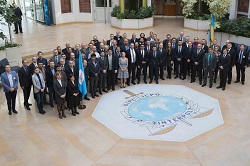Novel voice recognition technology completes Interpol’s legal arsenal
Imagine a criminal, face hidden, recorded by a security camera as he threatens one of his victims. Or a monitored phone conversation between a suspected drug trafficker and an unknown person who seems to be pulling the strings. In such scenarios, a 100 % accurate voice recognition technology would be a game changer. Although voice recognition can already be presented as legal evidence, there is still scepticism around its scientific grounds. The EU-funded SIIP (Speaker Identification Integrated Project) aims to discard these doubts with an innovative probabilistic, language-independent identification system. This system uses a novel Speaker-Identification (SID) engine and a Global Info Sharing Mechanism (GISM) to identify unknown speakers who are captured in lawfully intercepted calls, recorded crime or terror arenas, social media and any other type of speech source. SIIP’s strong point resides in the merger of multiple speech recognition algorithms related to speaker model, gender, age, language and accent provided by different vendors. This fusion results in highly reliable and confident detection, keeping false positives and false negatives to the minimum. By using this technology, Law enforcement agencies (LEAs) can overcome the two main challenges they have been facing up until now: the evasion problem, which consists in the use of hidden, fake and arbitrary identities by terrorists and criminals in phone or Internet-based conversations; and the difficulty in identifying an unknown conversation in a lawfully-intercepted call of a known speaker. Once the conversation has been recorded, SIIP will enable the identification of speakers by comparing their voices to rich-metadata from various sources and enable information sharing with LEAs across the world via Interpol. This way, law enforcement agents can gather valuable intelligence to prevent a crime or terrorist activity, solve it if it has already happened, and use voice identification as a pre-forensic tool to create evidence for judges. The system has already been demonstrated by the project’s end user partners themselves in real cases, including identification of speakers on social media and information sharing between users. The consortium indicated that the feedback was really positive, to the point where SIIP may actually join other Interpol central biometric databases such as fingerprint, face and DNA. This would not only enhance Interpol’s global activity of information sharing between its 190 member states, but also improve and expedite investigation work. Although the project ends in April 2018, SIIP’s development phase is completed, and the consortium says that the system will be ready for commercialisation in a ‘very short time’. A budget should be allocated by the EU and Interpol to create a spin-off company that they would officially support and promote. This spin-off company will take care of marketing and sales, customisation to specific customers’ needs, maintenance and future developments.







